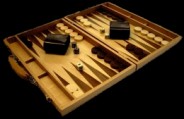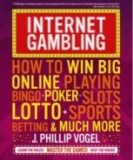
Internet Gambling
The Backgammon Revolution, Part 1
"These two shall sit at Tables...,” describes The Codex Exoniensis of the game ‘Tables,’ known commonly today as backgammon. Written in 1025 AD, this marks the first appearance J. Phillip Vogel is considered a leading authority in online gambling. He has written for most of the major gaming publications worldwide including Casino Player, Strictly Slots, Gambling Online, Bluff, and many more. He is also the author of a series of best-selling gambling books collectively titled The Real Deal. He is the founder of online watchdog site TheOPN.com at www.theopn.com and currently serves as the Editorial Director for Poker Life magazine.
J. Phillip Vogel is considered a leading authority in online gambling. He has written for most of the major gaming publications worldwide including Casino Player, Strictly Slots, Gambling Online, Bluff, and many more. He is also the author of a series of best-selling gambling books collectively titled The Real Deal. He is the founder of online watchdog site TheOPN.com at www.theopn.com and currently serves as the Editorial Director for Poker Life magazine. 
Backgammon Board in English print of the game that would so deftly envelop the gaming world. Surprisingly, despite the age-old notation in The Codex, backgammon is actually substantially older. The world’s oldest game is now better than ever.
Backgammon games have been played for thousands of years and in almost every part of the world. Wooden gaming boards and 3 x 10 squares have been found extensively in archaeological sites in Egypt, while the Romans left a great deal of evidence of a game they called ‘Ludus Duodecim Scriptorum,’ or the game of the twelve lines. In Asia, the backgammon-like game ‘Nard’ appeared around 800 AD in South West Asia and its variants are still played today throughout the continent. Backgammon’s predecessors have also been found in Japan—there called Sugoroko—while its European dominance was sparked by the Arab occupation of Sicily in 902 AD. Nard or Tables was played throughout Europe extensively during the middle ages and became a very popular form of entertainment in English Taverns.
Moving past antiquity, the start of modern backgammon is marked by the introduction of the doubling cube. First used in the 1920s in New York, this cube enhanced the element of skill in backgammon, further increasing the game’s popularity. Despite this, backgammon was still very much a hobby left to the wealthy and it wasn’t until the 1970s that its appeal really caught on with the general public. Today, backgammon has firmly reclaimed its prominence as one of the most popular games worldwide, thanks in part to its newfound online presence, which has opened the door for millions of people to learn and play the game.
Backgammon is a two player game, the object of which is to be the first player to move all of their checkers into their home board and then off the table. It is played on a board consisting of 24 narrow triangles (called ‘points’), which alternate in color and are grouped into two, each having twelve triangles. The halves are formed by the two opposing sides of the board, with a vertical band down the middle called the ‘bar,’ where the checkers are placed when hit.
The points are numbered from one to 24, with checkers always moving from high to low numbers. As the players move their checkers in opposite directions, the one point for one player will be the 24 point for the other. Each player has 15 checkers and these begin the game with two positioned on the 24 point, five on the 13 point, three on the eight point, and five on the six point in their home board. A pair of dice determines the number of moves available to the players, and a doubling cube with numbers 2, 4, 8, 16, 32, and 64 on its faces is used to keep track of the stakes currently being played for.
Two timers govern backgammon. The local timer counts down 45 seconds in normal speed games, 30 seconds in fast games, 15 seconds in express games, in which time the player must make a move. This is reset after each move and, if it expires, the global timer starts ticking.
The global timer is set to three minutes in normal speed games, two minutes in fast games, one minute in express games, and only starts ticking when the local timer expires. This global timer governs the entire game. For example, in the case of a game at normal speed, if the player neither moves any checkers nor makes any transactions during the 45 seconds of the local timer, the global timer will start. If the global timer runs out, the player in control of the board will be declared the loser, and points will be awarded to his opponent according to the doubling cube. This will be counted as losing the game, regardless of the current state of the game board.
At the start of the game, two of each player’s checkers are positioned on the 24 point, five on the 13 point, three on the 8 point, and five on the 6 point in the player's home board. Before play begins the dice are rolled (one for each player), and the player with the higher number makes the first move, using the combination of his die throw and the opponent's. In the case of a tie, the dice are rolled again until one of the players gets a higher score. If possible, a player must move his checkers the number of points shown on each die. In other words, if a two and a five are rolled, two separate moves must be made, corresponding to the pips of the dice. The player may move two checkers, or may choose to move only one by combining both numbers. Play continues with players alternating turns after each roll.
Each player must move his checkers in a forward direction onto points that the opponent has not already occupied with two or more checkers. If a player rolls the same number on both dice the roll is called a ‘doublet,’ and each number must be played twice. Once more, all moves are distinct. For example, a player who rolls 5-5 has to play four moves of five spaces, with between one to four checkers.
Where checkers can land
A checker can land on any vacant point. It can also land on any point occupied by a player's own checkers. A checker cannot land on a point occupied by two or more of the opponent's checkers. If a player has no legal moves after rolling the dice because all of the points are occupied by two or more of the opponent's checkers, his turn is forfeited. If a player has a legal move for one die only, he must make that move and then forfeit the use of the other die. If the player has a legal move for either die, but not both, he must play the higher number.
Two or more checkers of one color on a point own that point. A single checker is known as a ‘blot.’ If one of the opponent's checkers lands on a blot, the blot is considered ‘hit,’ and is placed on the bar. That checker is temporarily out of play.
If a player has checkers on the bar, no other checker can be moved before re-entering all of his checkers on the bar. Any checkers on the bar must be reintroduced into the game before any other moves are made. The checker(s) must be entered on empty points or blots in their opponent's home board, according to a throw of the dice. If there are no empty points, the player must forfeit their go. After the last of a player's checkers have re-entered the game, he must play the rest of the numbers shown on the dice if possible.
When a player has all 15 of their checkers in their own home board, he can start to remove them from the board; this is known as ‘bearing off.’ The player can bear a checker off corresponding to each number on the dice—a four will allow them to remove a checker from the 4 point. If there is no checker on the point indicated by the roll, the player must make a legal move using a checker on a higher-numbered point. If there are no checkers on higher-numbered points, the player is required to remove a checker from the highest point on which one of his checkers resides. A player is under no obligation to bear off if he can make an otherwise legal move.
A checker that has been borne off cannot re-enter the game. If a checker is hit during bear off, no other checkers can be borne off until that checker re-enters the game from the bar and reaches the player’s home board again.
Backgammon is played for an agreed stake per point. Each game starts at one point.
If a player is confident of a win, he can use the doubling cube to increase the bet. This must only be done before the player rolls the dice. The doubling cube's faces are numbered 2, 4, 8, 16, 32, and 64.
If the second player declines the increase in the stakes, he instantly loses the game and loses a point. However, when the second player accepts the doubling of the stakes he then takes control of the cube, meaning that only he can increase the stakes again.
Subsequent doublings of the stake are known as redoubles. If a player rejects a redouble, then they lose the game by the amount of points shown on the doubling cube. Alternatively, the player who accepts the redouble becomes the owner of the doubling cube.
The first player to get all of their checkers off the board wins. The loser either loses by a single point, or by the number of points shown on the doubling cube. The loser forfeits twice the stake if he has not moved a single checker off the board by the end of the game. This is known as a ’gammon.’ If the loser still has checkers on the bar or in the winner's home board, they lose triple the stake. This is known as a ‘backgammon.’
The following article in this series The Backgammon Revolution will continue next week.
